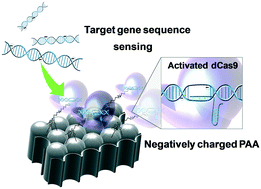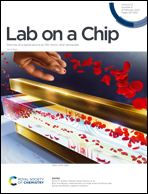Direct MYD88L265P gene detection for diffuse large B-cell lymphoma (DLBCL) via a miniaturised CRISPR/dCas9-based sensing chip†
Abstract
Traditional methods for single-nucleotide variants based on amplification and fluorescence signals require expensive reagents and cumbersome instruments, and they are time-consuming for each trial. Here, a porous anodised aluminium (PAA)-based sensing chip modified with deactivated Cas9 (dCas9) proteins and synthetic guide RNA (sgRNA) as the biorecognition receptor is developed, which can be used for the label-free sensing of the diffuse large B-cell lymphoma (DLBCL) MYD88L265P gene by integrating with electrochemical ionic current rectification (ICR) measurement. The sgRNA that can specifically identify and capture the MYD88L265P gene was screened, which has been proved to be workable to activate dCas9 for the target MYD88L265P. In the sensing process, the dCas9 proteins can capture the genome sequence, thus bringing negative charges over the PAA chip and correspondingly resulting in a variation in the ICR value due to the uneven transport of potassium anions through the ion channels of the PAA chip. The whole sensing can be finished within 40 min, and there is no need for gene amplification. The CRISPR/dCas9-based sensor demonstrates ultrasensitive detection performance in the concentration range of 50 to 200 ng μL−1 and it has been proved to be feasible for the genome sequence of patient tissues. This sensor shows the potential of targeting other mutations by designing the corresponding sgRNAs and expands the applications of CRISPR/dCas9 technology to the on-chip electrical detection of nucleic acids, which will be very valuable for rapid diagnosis of clinically mutated genes. This makes the hybrid CRISPR–PAA chip an ideal candidate for next-generation nucleic acid biosensors.

- This article is part of the themed collection: Miniaturised Sensors & Diagnostics


 Please wait while we load your content...
Please wait while we load your content...